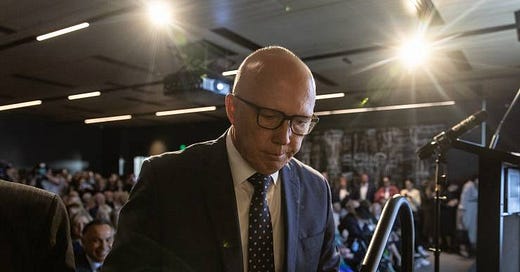Dutton’s decaying nuclear energy plans have the briefest half-life
Every time the opposition leader starts down the nuclear path, he hits another dead end.
]
Peter Dutton can’t seem to take a trick on nuclear power. Any option he puts forward seems to vanish as soon as he makes a commitment.
Since Dutton became opposition leader, he’s pushed the idea of small modular reactors (SMRs). At least in their original concept, these were reactors small enough (say 50-to-70MW capacity) to be built in a factory and shipped to sites where they could be installed in whatever number was required. The leading candidate was NuScale, a US firm that had contracted with a group of utilities in Utah to develop a pilot project of 12 (later reduced to six) SMRs.
The idea had the enthusiastic backing of the Australian Nuclear Science and Technology Organisation (ANSTO), the government’s official adviser on nuclear technology. The ANSTO website includes information on how SMRs can be constructed in three to five years, and that the US will have them operational by 2026.
That sounded too good to be true, and sadly, it was — NuScale abandoned its project late last year. After a bit of prodding, ANSTO added a disclaimer and a note that the “three to five year estimate” came from a research paper by the University of Leeds, which in turn could be traced to a dodgy consulting report from 2014.
On nuclear, Coalition prefers the optimism of misleading, decade-old, unverified claims
Having given up hope on NuScale, Dutton needed an alternative.
He settled on Rolls-Royce, a reassuringly familiar name with a long track record of engineering excellence, not always matched by its financial success (it was famously nationalised and broken up by the Conservative UK government in the 1970s). It produces the nuclear reactors to be used in the submarines we will acquire under the AUKUS deal.
Rolls-Royce also offers what it calls an SMR, though this is something of a misnomer. At 470MWe, the reactor scarcely qualifies as small. It’s far too big to be built in a factory and shipped to its installation site. The “modular” description refers to the fact that the design uses 1,500 “modular components”, which are to be produced in a factory then assembled on site.
This is precisely the approach that was attempted, unsuccessfully, in the Westinghouse AP1000 design. Of four AP1000 reactors started in the US, two were abandoned with a loss of billions of dollars while the other two (at Vogtle in Georgia) have finally been completed, years late and billions over budget.
Despite these concerns, Rolls-Royce looked like a frontrunner, at least in the UK. Its design was the first to enter the Office for Nuclear Regulation approval process in 2021, with a target delivery date of 2030. The UK government provided £210 million (about A$400 million) in funding to support the project.
So, late last week, Dutton briefed Simon Benson at The Australian on a plan to deliver Rolls-Royce reactors into the grid by the mid-2030s.
What could go wrong? Plenty it seems. Just as The Australian story appeared, the UK government announced the winners of a grant to build SMRs in County Durham, and Rolls-Royce was not among them. UK deployment of the Rolls-Royce design now seems unlikely.
Rolls-Royce is now talking about building its first plants overseas. Poland has been mentioned as a possibility, but that’s a furphy. Under the now-departed Law and Justice government, Poland announced deals involving a string of different reactor designs: the AP1000, the GE Hitachi Nuclear Energy’s BWRX-300 (a direct competitor for Rolls-Royce), Last Energy microreactors, and even NuScale. Few if any will actually be built.
So, if Dutton goes ahead with Rolls-Royce, Australia could be in the unenviable situation of building “first of a kind” (FOAK) reactors with an untested design. Even more than nuclear plants in general, FOAK projects are notorious for delays and cost overruns. For a country like Australia, with no established nuclear industry or regulatory structure, it would be madness to try such a thing.
What next for Dutton’s nuclear policy? There’s still time for a climbdown before the policy is officially announced, but it’s unclear that the nuclear true believers in the LNP would accept such a thing. He could switch to a design with slightly better chances, such as the BWRX-300, but that would risk a third embarrassment if the design failed. So he has little choice but to press ahead with the Rolls-Royce dream and hope that it is not finally dispelled before the 2025 election.
Read my newsletter





While the ALP is providing obvious reasons not to vote for it, it's wild to me that there's as much competition in the 2PP vote as there is, at least as reported by Poll Bludger. Nuclear power is a non-starter for most of the electorate, we will hear a lot more about it in the run up to the next election. Here's hoping for a few more independents to give the ALP the minority government they deserve, and we never have to hear about nuclear power for Australia ever again.
Another line of enquiry. Who would build and operate the new nuclear power stations? I could not find any Australian university offering a Bachelors degree course in nuclear engineering - there are several in nuclear medicine, which is irrelevant. Two universities, UNSW and ANU, offer Masters courses in the field. I could not find how many degrees are awarded each year, but it's not likely to be many. A significant national nuclear reactor programme would require hundreds of nuclear engineers. In practice they would have to be Chinese or Indian. Is this what Dutton's culture-war voters are looking for?